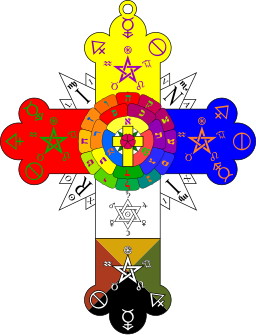As it turns out, given the heavy reliance of the Adeptus Minor work in the Golden Dawn tradition on color theory and on proper coloring of tools, there seem to be very few specific resources out there for people who are looking to use these colors in their own practical work. This is especially true when it comes to digital values of the various colors used in the tools.
There have been a couple of attempts to render the Flashing Colors in digital palettes, notably among them the Lelandra.com page, and we can see an attempt to do so represented in the Rose Cross Lamen image we see in Wikimedia Commons:
The challenge that arises is that these attempts clearly begin from a standpoint of digital color representation and derive the color palette from there. Conversely, in the historical Golden Dawn tradition the colors of the Hodos Chameleonis were derived by mixing of paints, not of digital palettes. Something does get lost in the translation.
Thankfully, Tabatha Cicero is likely as close to a modern-day Moina Mathers as we have in the Golden Dawn tradition, and she had the foresight to include Munsell values for the paints she recommended in Secrets of a Golden Dawn Temple. Unfortunately she did seemingly omit the values for Deep Magenta / Quidraquinone Violet (i.e. “Red-Violet”), but I tracked down a Liquitex reference book on their acrylics, and obtained Munsell values for the closest matching color represented in their line.
Having amassed a list of Munsell values, I tracked down a Python-based Munsell to RGB converter website and entered Tabby’s values in one by one. In some cases this resulted in RGB values that were outside the integer boundaries (either going slightly negative or a bit over 255), but resulted by and large in a very usable digital palette. I was somewhat surprised in that the colors were not only somewhat more muted than I anticipated, but the blues in particular (Tabatha gives two alternatives) were notably lighter than the palette given in the Wikimedia Commons lamen.
I’ve been playing around with trying to derive RGB color values lately for the Golden Dawn palette, and I’ve tried several approaches. My last attempt involved using Munsell’s canonical colors (e.g. Munsell blue) as a reference point and deriving colors from there, but I find that replicating the Liquitex color values that Tabatha Cicero presents has given a much more appealing palette and one which matches much more closely with the documents and exemplars with which I am familiar.
By contrast, here is the same Rose Cross Lamen from Wikimedia Commons, colored appropriately in the Munsell palette derived from Tabby’s work:

And now that I’ve given you the obligatory detail on my process, I won’t spare you the detail any longer. Below are the RGB and hexadecimal color values derived from the Golden Dawn Liquitex/Munsell palette, courtesy of Tabatha Cicero. There are some notes to a few of the entries, which I’ll cover afterwards.
Most notably, there are two variants given for Red and for Blue. There isn’t a lot of difference between the reds, but the versions provided are based on the Munsell values Tabatha Cicero gives for Naphthol Red Light and Cadmium Red Medium, respectively. She also provides Munsell values for both Brilliant Blue and Cerulean Blue, which are represented above; I find I prefer the darker of the two represented by Cerulean Blue, but your mileage may vary. As mentioned previously, no Munsell value was given for Deep Magenta or Quinacridone Violet, so the Munsell values used here come from the Liquitex Deep Magenta #300 catalog entry.
I hope this helps those of you who are doing digital work in the Golden Dawn space! I have more to write about the physical pigments used for painting tools as well, but I’ll save that for another post. If you have any questions or feedback, please feel free to comment or drop me a line!
















Leave a Reply